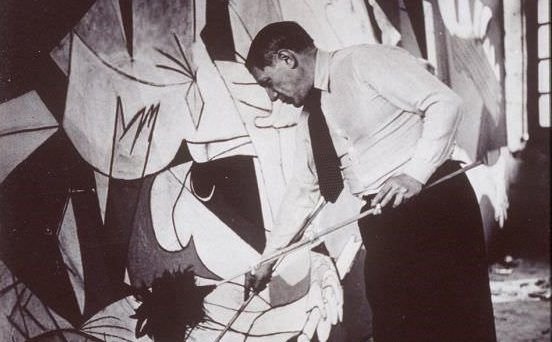Guernica, 1937 by Pablo Picasso
Probably Picasso's most famous work, Guernica is certainly the his most powerful political statement, painted as an immediate reaction to the Nazi's devastating casual bombing practice on the Basque town of Guernica during Spanish Civil War.

Guernica shows the tragedies of war and the suffering it inflicts upon individuals, particularly innocent civilians. This work has gained a monumental status, becoming a perpetual reminder of the tragedies of war, an anti-war symbol, and an embodiment of peace. On completion Guernica was displayed around the world in a brief tour, becoming famous and widely acclaimed. This tour helped bring the Spanish Civil War to the world's attention.
This work is seen as an amalgmation of pastoral and epic styles. The discarding of color intensifis the drama, producing a reportage quality as in a photographic record. Guernica is blue, black and white, 3.5 metre (11 ft) tall and 7.8 metre (25.6 ft) wide, a mural-size canvas painted in oil. This painting can be seen in the Museo Reina Sofia in Madrid.
Interpretations of Guernica vary widely and contradict one another. This extends, for example, to the mural's two dominant elements: the bull and the horse. Art historian Patricia Failing said, "The bull and the horse are important characters in Spanish culture. Picasso himself certainly used these characters to play many different roles over time. This has made the task of interpreting the specific meaning of the bull and the horse very tough. Their relationship is a kind of ballet that was conceived in a variety of ways throughout Picasso's career."
Some critics warn against trusting the political message in Guernica. For instance the rampaging bull, a major motif of destruction here, has previouse figured, whether as a bull or Minotaur, as Picasso' ego. However, in this instance the bull probably represents the onslaught of Fascism. Picasso said it meant brutality and darkness, presumably reminiscent of his prophetic. He also stated that the horse represented the people of Guernica.

Historical context
Guernica is a town in the province of Biscay in Basque Country. During the Spanish Civil War, it was regarded as the northern bastion of the Republican resistance movement and the epicenter of Basque culture, adding to its significance as a target.
The Republican forces were made up of assorted factions (Communists, Socialists, Anarchists, to name a few) with wildly differing approaches to government and eventual aims, but a common opposition to the Nationalists. The Nationalists, led by General Francisco Franco, were also factionalized but to a lesser extent. They sought a return to the golden days of Spain, based on law, order, and traditional Catholic family values.
At about 16:30 on Monday, 26 April 1937, warplanes of the German Condor Legion, commanded by Colonel Wolfram von Richthofen, bombed Guernica for about two hours. Germany, at this time led by Hitler, had lent material support to the Nationalists and were using the war as an opportunity to test out new weapons and tactics. Later, intense aerial bombardment became a crucial preliminary step in the Blitzkrieg tactic.
After the bombing, Picasso was made aware of what had gone on in his country of origin. At the time, he was working on a mural for the Paris Exhibition to be held in the summer of 1937, commissioned by the Spanish Republican government. He deserted his original idea and on 1 May 1937, began on Guernica. This captivated his imagination unlike his previous idea, on which he had been working somewhat dispassionately, for a couple of months. It is interesting to note, however, that at its unveiling at the Paris Exhibition that summer, it garnered little attention. It would later attain its power as such a potent symbol of the destruction of war on innocent lives.
Guernica, Picasso's most important political painting, has remained relevant as a work of art and as a symbol of protest, and it kept the memory of the Basque town's nightmare alive. In the postwar years, it would hang next to Da Vinci's The Last Supper on the walls of many Spanish households as a form of silent dissent against Franco.